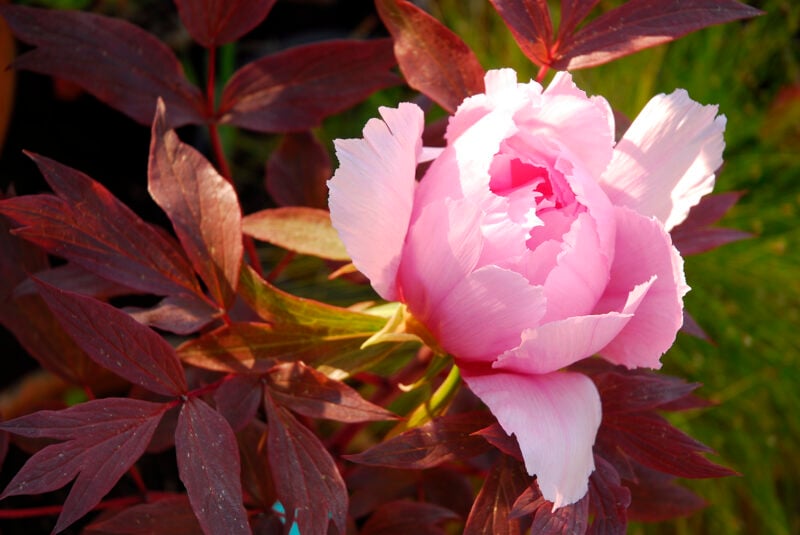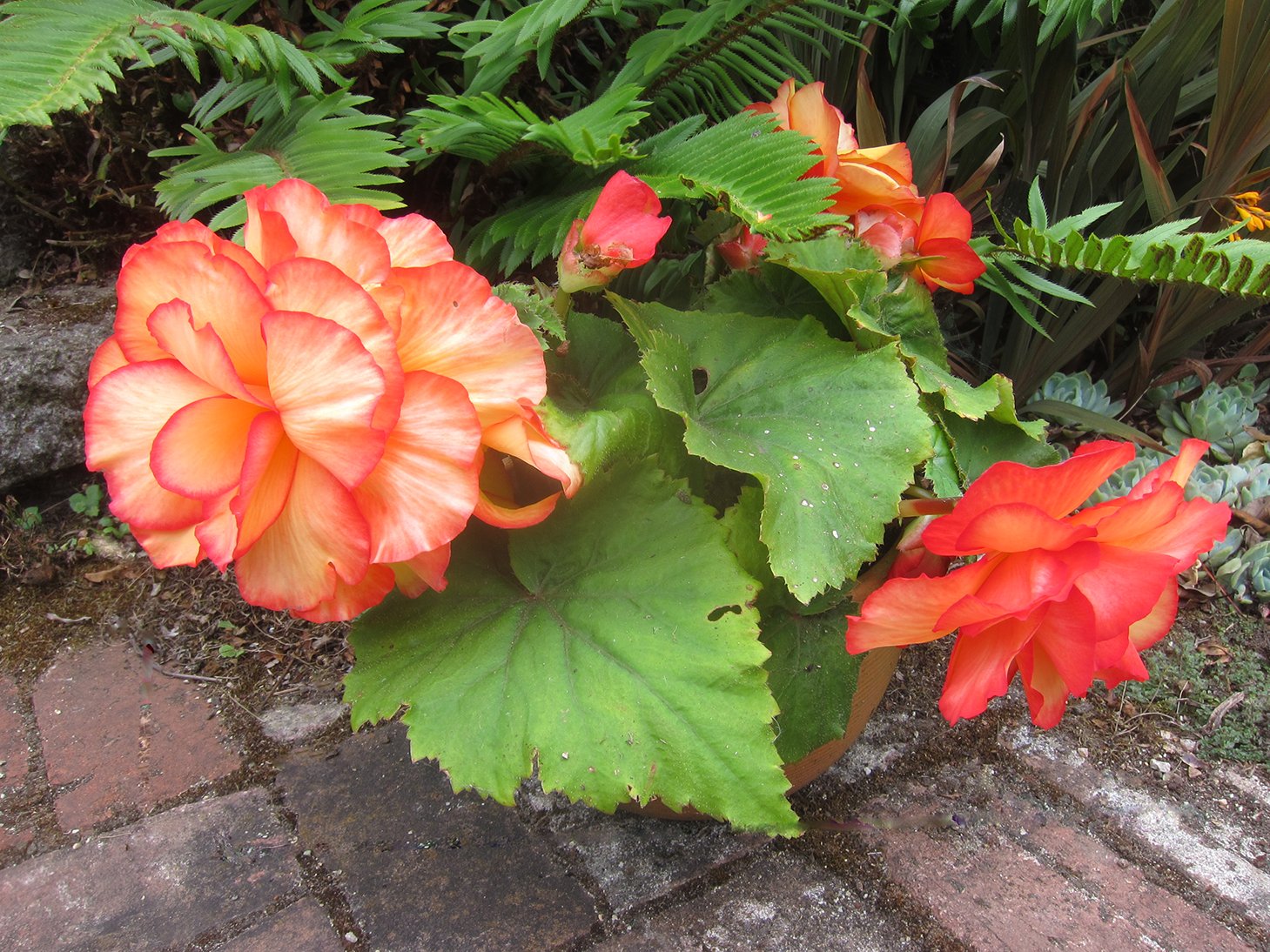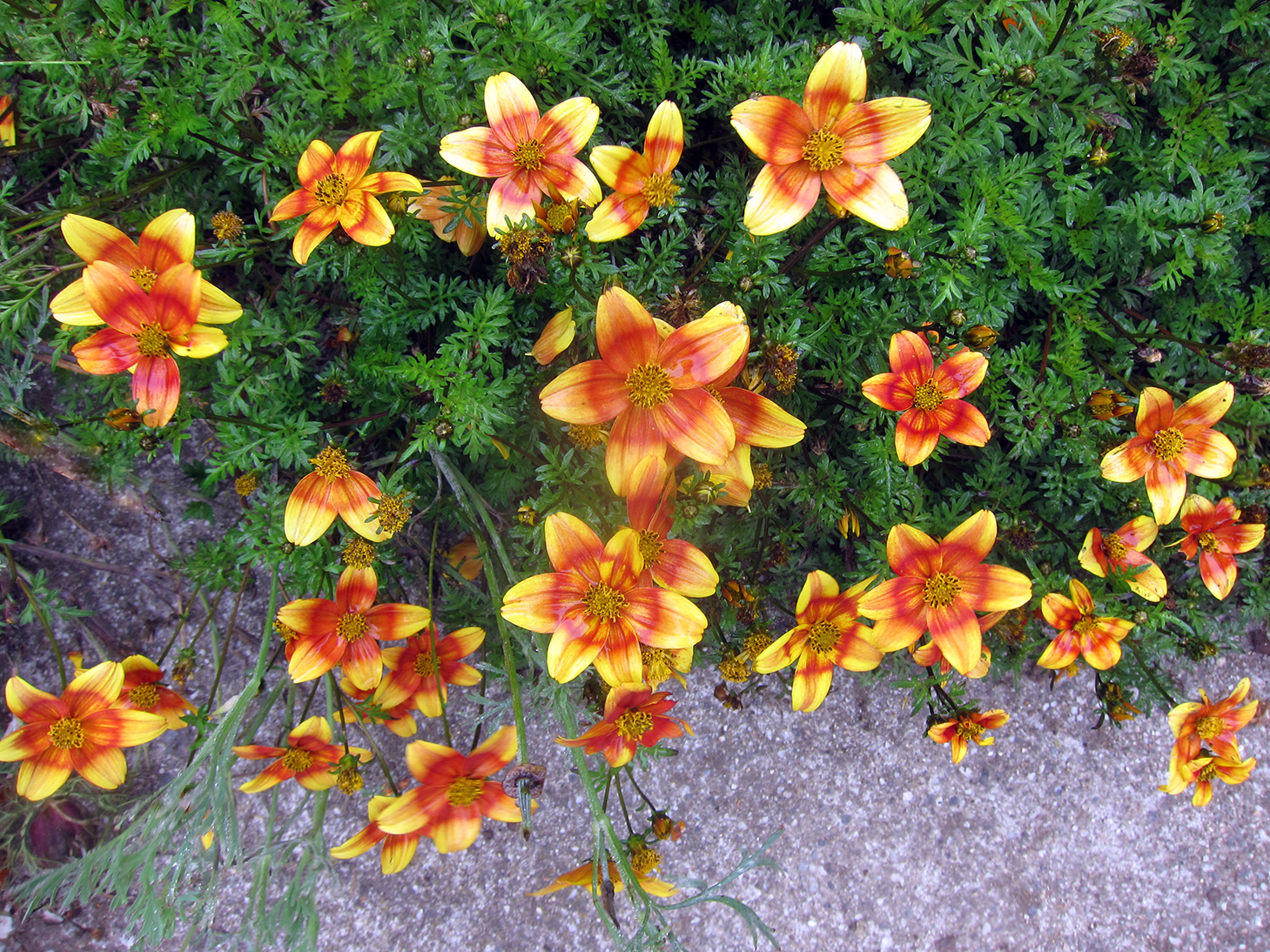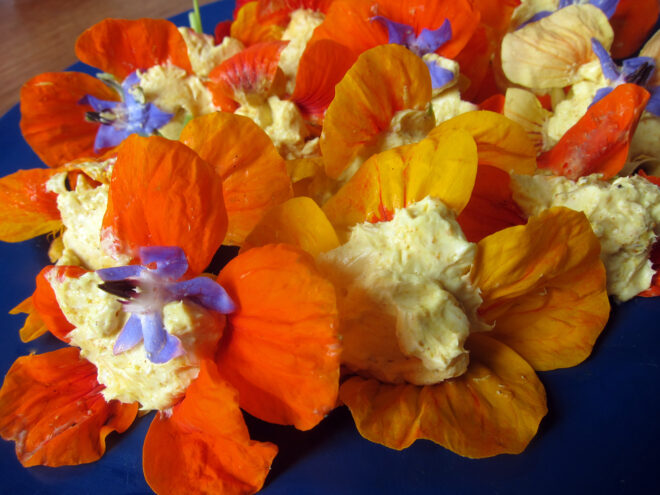
Eat Flowers: A Plateful of Groundcovers, Annuals, and Perennials

Contributor
- Topics: Nature is Good For You
Fall 2023
Humans have always eaten flowers, often accidentally, as part of the plant they were eating, sometimes intentionally, as in the pickling of caper buds, the steeping of rose petals to make rose water, or the use of peony petals in early Chinese cuisine. When we eat cauliflower and broccoli, we are eating flower buds and their stems. We even think of artichokes as edible flowers, though what we actually eat is the tender parts of bracts and the receptacle that surround the flower buds, which we discard.
More flowers in your garden are edible than you ever imagined. Using them will let you experience the delightful cheerfulness they add to a meal as well as letting you harvest from your garden without setting aside a place to grow food.
The ornamental flowers and herbs listed below are the ones that are commonly known from past periods when edible flowers were popular.

Edible flowers had their first of three heydays in Western culture during the late Medieval and the Renaissance era. A representative recipe from that era is the grand sallet (great salad). It contained a wide variety of edible greens, herbs, dried fruit, almonds, capers, possibly diced meats and hardboiled egg, and generally a bright scattering of edible flowers. A chef might toss a grand sallet before serving or arrange the salad as separate ingredients that diners served themselves. In the centuries when grand sallets were popular, only a few were wealthy enough to serve great banquets with such lavish dishes. The ingredients were an expression of status. The process of crystalizing flowers was developed in the Renaissance, and the sugar-preserved flowers decorated elaborate desserts. The idea of using pressed, dried flowers to decorate prepared food, also a popular practice in Europe in this era, derived from a technique that originated in Persia.
The second period when menus frequently featured flowers was the Victorian era, roughly the second half of the nineteenth century, in England, Europe, and North America. In this flower-steeped culture, flowers were much used as ornaments in foods and arrangements. Flower cuisine included a few “New World” blossoms, such as nasturtiums (Tropaeolum), that were unknown or less known in the earlier era. A typical use for edible flowers was in jams and jellies, such as rose petal jam, made with the petals, sugar, and lemon juice. As in the Renaissance, flowers lavishly decorated salads and desserts.
In the present era, edible flowers, once again becoming popular, are often sold at grocery stores in plastic “clam shells.” This practice has limited choices to the ones that ship well, and to those best known to be edible. In addition, because they are a pricey item, it has meant that they have become a luxury. But you can avoid the high price when you know how many common flowers you can harvest from a small space—even a container garden. And when you are harvesting flowers from your own garden, you can expand your choices to many that are less well known or would keep too poorly to be commercially viable.
In our era, we are learning more and more flowers are edible. As different cultures share cuisine with one another, we learn what plants are good to eat. We can now chemically analyze plants and their flowers, then add to the edible list ones that do not contain toxic levels of harmful compounds. Finally, we simply are rediscovering flowers that were eaten in past eras but have fallen out of favor and out of common memory. I will focus on the edible flowers of groundcovers, annuals, and perennials, describing a few that are less well known, though this article should not be considered definitive.
Traditional edible ornamental annual and perennial flowers include:
Borage (Borago officinalis)—whole flowers or remove calyx; tastes like cucumber
Carnations (Dianthus caryophyllus)—use the petals; remove bitter white heel
Cornflower (Centaurea cyanus)—whole flower or “petals” (ray florets), as decoration
Cowslip (Primula veris)—whole flower, fresh or pressed
Dianthus—same instructions as for carnations
Chamomile (Roman, Chamaemelum nobile and German, Matricaria recutita)—whole flower, mostly for tea
Marigold, pot (Calendula)—pick off and eat “petals”
Marigold, true (Tagetes)—tear off “petals” (the ‘Gem’ series of signet marigold, Tagetes tenuifolia, is particularly tasty)
Nasturtium (Tropaeolum)—whole flower has a peppery flavor when raw
Pansy (Viola x wittrockiana)—whole flower or tear off petals
Tulip (Tulipa)—petals; paler ones said to have better flavor
Viola—whole flowers
Violet—whole flowers
Groundcovers
Some surprises rest among plants grown as groundcovers or bedding plants. It turns out that you can eat the blossoms and leaves of the creeping bellflower (Campanula portenschlagiana and C. poscharskyana), blue- or white-flowered, and also those of yellow archangel (Lamiun galeobdolon), and busy lizzie (Impatiens walleriana). Add the small white flowers and small leaves of sweet alyssum (Lobularia maritima) to your list of edibles. Alyssum has a sweet fragrance and shares a peppery flavor with many other mustard family (Brassicaceae) flowers.
While the more commonly eaten part of a Hosta (Hosta spp.) is the “hoston,” the very young, unfurled leaves as the plant emerges in spring, the blue, lavender, or white flowers are also edible. Hosta is adapted throughout the Pacific region, but if you have snails or slugs, they will tatter the broad, often white-variegated, leaves.
Flowers and leaves of the common garden primroses and their hybrids (Primula vulgaris and P. x polyantha) are edible. The primrose listed among the “commonly known” edible flowers is cowslip (P. veris), native to the British Isles. Just don’t eat poison primrose (P. obconica, also known as German primrose), which, as its common name suggests, is toxic.
Most children have tasted the tart flowers of weedy creeping oxalis (Oxalis corniculuata), so they know that you can taste these tart blossoms, but not eat them in quantity, due to their high content of oxalic acid. The same goes for other weedy oxalis species, as well as for several oxalis species that are sold as groundcovers. Many vegetables also contain oxalic acid, but high concentrations of it, such as are in oxalis, make it wise to eat only a few flowers, and none at all if you have kidney stones, gout, or rheumatoid arthritis. Bedding begonias (Begonia sempervirens) are also edible but with a somewhat tart, citrusy flavor due to oxalic acid. (See perennial tuberous begonias, below.)

Annuals
Many of the commonly known edible flowers are annuals. Possibly the best known of these is nasturtium (Tropaeolum), the peppery, usually orange or yellow, South American flower. Newly added, or newly reappreciated, are Angelonia, cockscomb and the similar feather flower (Celosia species and hybrids), wild and domestic English daisy (Bellis perennis), cosmos (Cosmos bifida and C. sulphureus), and annual forget-me-not (Myosotis sylvatica). Snapdragons (Antirrhinum) can also be eaten, but their flavor is so bitter they make a better garnish than food.
Finally, there are annual mallow relatives, including the many-colored hollyhocks and the three-to-four-inch pink or white flowers of silver cup lavatera (Lavatera trimestris ‘Silver Cup’). Victorians didn’t eat either of these, but they were very fond of tea made from the red calyxes of the closely related roselle (Hibiscus sabdariffa). While this is a tropical perennial, thought to have originated in West Africa, you can grow it as an annual wherever summer is long and hot, and use the calyxes as did the Victorians, to make a tart red tea. (Try steeping it with peppermint leaves and serving it cold and sweetened.) In addition to the calyxes, you can pick some of the flowers to use the pink petals in salad.
Vegetable gardeners know that bean flowers taste beany, including the red blooms of scarlet runner bean (Phaseolus coccineus) and the stylishly black-and white blossoms of fava bean (Vicia faba). Arugula (Eruca vesicaria) blossoms taste like arugula. Onion family (Alliaceae) vegetable flowers taste oniony. Squash (Cucurbita spp.) blossoms are delicious when dipped in seasoned flour and fried or cooked with a savory filling.
Gardeners also know herb flowers share the flavor of the herb. Cooks may eat the flowers of herb plants separately or just leave them on the blooming tips as a bonus. Perilla (Perilla frutescens), a mint family annual plant used in Korean and Japanese cuisine, is pretty enough for an ornamental garden and has small, edible, white-to-lavender flowers. Herb blossoms are often tiny, but the purple flowers of garden sage are about a half-inch long, and winter tarragon (Tagetes lucida) is a newly popular herb with yellow marigold-type edible flowers about half an inch across. Pineapple sage (Salvia elegans) has bright red flowers that bloom into fall, best used raw, as they lose their pineapple scent when cooked.
Perennials
Among perennial flowers, we can add quite a few to the traditional list. Gardeners in cold-winter areas will be pleased to know that the petals of cinquefoil (Potentilla spp.) are edible. In areas with mild winters, Bidens species and cultivars are likely to bear their edible yellow, burnt-orange, or bicolored edible flowers year round.

Gardeners in colder climates have a perennial hibiscus that they can grow instead of the tropical hibiscus shrub. The hardy hibiscus, rose mallow (Hibiscus moscheutos), gets a bit woody but is classified as a perennial because it dies back each winter and regrows in spring. It blooms in several colors and its colorful, mild-flavored flowers are six to nine inches across. As with any mallow-related flower, discard the pistil and stamen cluster, eating only the petals. Also edible are spiderwort blossoms (Tradescantia virginiana—often sold as Andersoniana group). These mounding border plants reach 1.5 feet tall and are adapted throughout the Pacific region. The flowers can be purple, lavender, or pink. You can eat the white blossoms of candytuft (Iberis sp.) which have a flavor like sweet broccoli, another mustard family plant. In fact, the flowers of most mustard family plants are edible, though some, such as the annual moneywort (Lunaria annua) are not recommended as garden flowers due to their rampant self-seeding.
Dried daylily (Hemerocallis spp.) flowers are the “golden needles” of Chinese cuisine, used in hot and sour soup and moo shu pork. You can also use the flowers fresh in stir fries, soups, or salads. These are not true lilies (Lilium), but Hemerocallis lilies in the asphodel family (Asphodeliaceae). They bloom in a myriad of colors, though the yellow one, the semi-evergreen lemon daylily (H. lilioaspodelus), is said to have the best flavor. Always remove the stamens and pistils before you eat these flowers. Check climate adaptability when you purchase plants. Winter dormant types are extremely hardy; evergreen ones are better adapted where winters are milder. Most flower best with at least a little warmth in summer.
Chrysanthemum (Chrysanthemum x grandiflorum) “petals” (ray florets) have been eaten in China and Japan for centuries but are not well utilized in our kitchens. Like daylilies, they can be chopped and used in soups (added near the end of cooking) or raw in salads. Pull off all of the petals and cut off their white heels, which can be bitter. (While chrysanthemums are hardy enough to become perennials in all of our region, plants forced in greenhouses to bloom in seasons other than fall will revert to fall blooming and may need several years to recover from this forcing.) Note that the annual used to produce edible chrysanthemum greens (Glebionis coronaria) also has edible flowers, in bright yellow or two-tone white and pale yellow. Pull off the petals to eat them, and, if you grow it, prevent it from seeding, as it will become a pest if it resows itself.
Aztecs enjoyed Dahlia tubers, though modern breeding has focused mainly on the appearance of the flowers. The “petals” (ray florets again) are also edible. Most varieties have reasonably good-tasting petals, so if it is edible flowers we want, we can just grow them for color and form and enjoy eating the petals as a side benefit.
Peony (Paeonia spp.) petals have been eaten in China for many centuries, forming part of a sauce that Confucius (551–479 BCE) enjoyed. You can gather them as they fall (so you get to enjoy the flowers first) and eat them blanched and sweetened or as a garnish. They are gorgeous blossoms, big and lush looking. Their relative anonymity as an edible flower may relate to their short (7–10 day) spring bloom period. The plants are hardy to US Department of Agriculture (USDA) Hardiness Zone 3 (minus 40°F and minus 40°C) but are not well-adapted to areas milder than Zone 7 (0°F or minus 18°C). Tree peonies, a woodier type, are not quite as hardy—USDA Zone 4—minus 30°F or minus 34°C) and are somewhat more likely to bloom in low chill areas.
Flowers of tuberous begonia (B. tuberosum) add splendid, bright color when cut up and sprinkled on a salad, though as with any tart, oxalic-acid-containing flower, you don’t want to eat it in quantity, especially if you have kidney issues, gout, or rheumatoid arthritis. These plants need a shady location and will survive little or no frost. If you live in Zone 8 or colder, it is best to remove the tubers from containers or beds and let them overwinter dry in an airy, shady, indoor location. Even where they are winter hardy, it is best to tip the pots on their side in rainy winters, so the soil can stay dry.
Most iris family (Iridaceae) plants are toxic, though those of gladiolus (Gladiolus grandiflora and its hybrids) are edible. Remove gladiolus pistils and stamens, then use the petals as garnish or to hold some tasty concoction. Freesia (Freesia species and hybrids), another iris family flower, is also edible, said to be delicious as flavoring for a sorbet. Neither can survive cold winters. In gardens colder than USDA Zone 8 (that is with a low of 10°F—minus 12°C—or less), you have to dig gladiolus corms and overwinter them in a cool indoor location. Freesia is even less hardy, and it is fussy to dig and store its small corms, so it is mostly grown in Zones 9–11, where there are only light or no frosts.
Though we know there are edible flowers in the lily family (Liliaceae), such as tulips, there are also toxic plants. Even tulips, the flowers of which are edible, sometimes carry a warning not to eat the green center of the bulbs. Some lilies, such as several star and Asiatic lilies, are poisonous. The word “lily” in a plant’s common name does not mean it is classified in the genus Lilium. Sorting out the edibility of members of the entire genus would require an article of its own.
Nasturtium Appetizer
Try this for a potluck or party. The curried cream cheese, the peppery blossoms, and the sweet nectar in the flowers’ spurs will surprise and please diners. The borage flower garnishes are optional.
20 nasturtium blossoms
1/2 cup cream cheese or vegan cream cheese alternative
1 teaspoon curry powder
Wash and examine the nasturtium flowers for insects. Set them on a paper towel to dry. In a small bowl, mix the cream cheese and curry powder well.
Spoon about a teaspoon of cheese into each flower and arrange the blossoms on a plate. If they can’t be served immediately, cover them with a wet paper towel and refrigerate them.
Recipe is from Golden Gate Gardening, by Pam Peirce

A word of caution
In general, be cautious when picking flowers to eat, and ensure that you have positively identified the plant as one with flowers that can be eaten. Don’t assume that all flowers are edible. While many more can be eaten than most people think, some are quite toxic. I will list a few kinds of flowers that are toxic below, though this is not at all a complete list. Nor are all parts of plants with edible flowers necessarily edible. In some cases, plants may have flowers you can eat, but other parts—such as bulbs or seeds—are toxic, so be sure each part of a plant is harmless before you eat it.
Do not eat flowers that may have been sprayed with toxic pesticides. This means do not eat flowers you bought at a florist’s or recently bought from a nursery, unless the nursery can guarantee they were grown using organic methods. Also avoid eating flowers that were growing by a roadside, where they are probably contaminated by substances from motor vehicles.
Some people are allergic to certain plants, so use caution in trying edible flowers and announce to guests which flowers are in the dishes you serve them. Finally, what is edible by humans may be toxic to cats, dogs, horses, or other domestic animals. Although your pets may show no interest in eating your flowers, this information is good to know in case they nibble—or groom pollen from their fur, in the case of true lilies (Lilium spp.). Several organizations have online lists of plants toxic to various domestic animals, for example, the American Society for Prevention of Cruelty to Animals (ASPCA) includes printable lists of plants toxic or nontoxic to different domestic animals, and pictures of most of the plants they list. Their Animal Poison Control Center phone number is (888) 426-4435.
List of some annual and perennial flowers known to be poisonous for humans
(Note: This is not a complete list, just a short one to encourage you not to eat flowers unless you know they are safe to eat.)
Arum lily (Arum spp.)
Castor bean (Ricinus communis)
Daffodil (Narcissus spp.)
Foxglove (Digitalis spp.)
Iris (all kinds)
Lily of the valley (Convalleria majus)
Monkshood (Aconitum spp.)
Naked lady lily (Amaryllis belladonna)
Ornamental sweet pea (Lathyrus spp.)
Periwinkle (Vinca and Catharanthus)
Resources
Plants for a Future describes edible uses for many plants.
Eat The Weeds includes many pages describing plants, some of them weeds, with edible flowers and other parts.
The Edible Flowers Guide by reputable British seed firm Thompson & Morgan includes a chart of common edible flowers, including suggestions for use.
The American Society for the Prevention of Cruelty to Animals (ASPCA) has a database of plants common around the home that are toxic to different animals, including lists specific to cats, dogs, and horses.










Responses